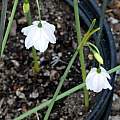This page shows an overview of all the species of Acis in the wiki. For information on the genus and links to the single species pages see Acis.
Acis autumnalis (L.) Sweet, syn. Leucojum autumnale is native to the Iberian Peninsula and grows to 4-8 inches (10-20 cm) tall. It begins to bloom in summer and continues to bloom well into the fall and forms a clump of dark green threadlike leaves that emerge after flowering and persist into spring. The flowering stem is usually red-tinted and the one to four white flowers are often red or pink at the base. It is hardy to about 20 °F. (-6 °C).
In 2002 it bloomed July-November in the Northern hemisphere. Ones I had in the ground dwindled away and it may be too dry in Northern California in the summer. The ones in pots are nearly evergreen. I withheld water in 2004 so I could divide them while not in growth, but had to hurry as they were starting to bloom in July without leaves present. The flowers are small, but shiny. Photos by Bob Rutemoeller, Mary Sue Ittner, and John Lonsdale.
Acis autumnalis var. oporantha, syn. Leucojum autumnale var. oporanthum is a variety now considered not to have variety status, but still sometimes seen under this name. It flowers before the leaves and is from the Rif Mountains. Another distinctive feature of this form is the pedicels arch from the middle of the base. The first photo by John Lonsdale and the next two taken September 2003 by Lee Poulsen.
Acis autumnalis var. pulchella, syn. Leucojum autumnale var. pulchellum, also no longer considered to be worthy of variety status, is from Northern Africa. It flowers with the leaves present and has pedicels arching over at the apex. Photo by John Lonsdale
Photo 1 below by Travis Owen of bulbs received as Acis autumnalis in BX 381 from Mary Sue Ittner. Second photo of seeds received from SX4 (2015).
Acis fabrei (Quézel & Girerd) Lledó, A.P.Davis & M.B.Crespo, syn. Leucojum fabrei, is a dwarf plant that produces only one flower per stem. It is rare and endemic to the Vaucluse area of Provence, France. It is similar to Acis nicaeensis but smaller and the latter has more than one flower per stem. Photos taken by Hans Joschko.
Acis longifolia J.Gay ex M.Roem., syn. Leucojum longifolium is a spring flowering species native to Corsica where it is found in rocky places below 1000 m. Its slender leaves overtop the small white flowers. Height: 20 cm. Photos taken by Hans Joschko.
Acis nicaeensis (Ardoino) Lledó, A.P.Davis & M.B.Crespo, syn. Leucojum nicaeense is native to a small area in southeastern France, near the Mediterranean. The stems are about 5 inches (12 cm) tall and the flowers pure white. It has dark, shiny, lax leaves and flowers in late spring and increases well in a bulb frame, kept somewhat dry in summer. Photo 1 by Jane McGary. Photos 2-3 taken by Hans Joschko. The last photo is from Bridget Wosczyna.
Acis rosea (F.Martin bis) Sweet, syn. Leucojum roseum F.Martin bis with the common name of rose snowflake grows wild in Corsica and Sardinia in dryish rocky or sandy places and has pale pink flowers. It blooms in late summer or early autumn before the thread like leaves are produced. It has fragrant pink flowers. Height range: 30-45 cm. Photos were taken by Mary Sue Ittner. The last photo shows the bulbs on a 1 cm grid.
Photos by John Lonsdale.
Acis tingitana (Baker) Lledó, A.P.Davis & M.B.Crespo, syn. Leucojum tingitanum is native to Morocco and Tangier and is a late winter to spring flowering species with 4-5 small white flowers on long nodding pedicels up to 45 cm. It is similar to Acis longifolia, but the leaves are shorter than the flowering stem. The first image is of plants grown and photographed by Rob Hamilton flowering in mid winter in Tasmania. Image 2 shows it flowering in late winter in a bulb frame in Oregon, grown from seed and photographed by Jane McGary. It is reputed to be tender, but the Oregon specimen is shown in bloom six weeks after experiencing temperatures in the low 20s Fahrenheit, under glass. Image 3 by Tony Goode shows it exhibited at Harlow Alpine Garden Society show in March 2002. The plants were exhibited by Jim Archibald. Photos 4-6 taken by Hans Joschko.
Acis trichophylla G.Don, syn. Leucojum trichophyllum, is native to Spain, Portugal, Morocco and Tangier where it is found in sandy places. It grows from 10 to 25 cm tall and has filiform leaves and 2 to 4 white or pink flowers. The perianth segments have sharp tips. According to Jane McGary, "it produces a great many bulblets, which grow to flowering size in about 2 years. It can be crowded and flower well" and that in her Northwestern Oregon climate, they should be "covered but not in heated frames in full sun, repotted every other year into very gritty soil and fed once in fall and 3 times in spring with soluble fertilizer." The first two photos below show the white form grown by Nhu Nguyen which flowers in early fall after a somewhat dry summer rest. Photos 3-5 taken by Hans Joschko.
Photos 1-2 by Alessandro Marinello and photos 3-4 taken by Hans Joschko are of forms with pink flowers.
Acis valentina (Pau) Lledó, A.P.Davis & M.B.Crespo, syn. Leucojum valentinum Pau, is from eastern Spain where it grows in sunny rocky places. Height: 12 cm. It is considered endangered in the wild as the populations are decreasing with development. It is a fall blooming species that bears white flowers with sharp points on the outer segments. It is also different from Acis autumnalis in another way by having a six-lobed disc at the base of the ovary. Photos 1 and 2 from John Lonsdale. Photos 3 and 4 from Jane McGary, showing a cluster of bulbs flowering in a garden in Portland, Oregon, in August.
Photos from Mary Sue Ittner. The last photo shows the bulb on a 1 cm grid.




















































